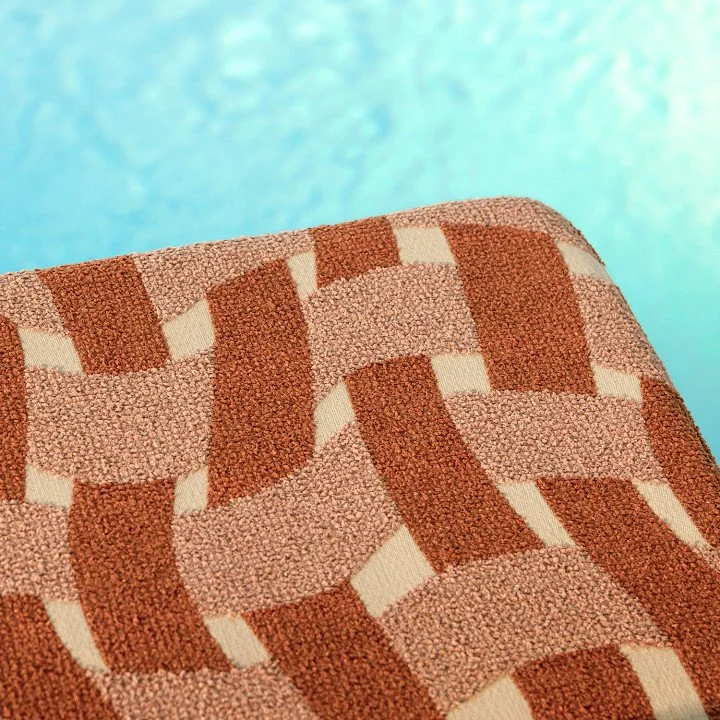The Ultimate Guide to Choosing Outdoor Upholstery Fabrics
HOW TO CHOOSE THE BEST FABRIC FOR YOUR OUTDOOR FURNITURE
Whether you’re designing a resort terrace, a restaurant courtyard, or your own backyard oasis, choosing the right OUTDOOR UPHOLSTERY FABRIC is essential. Australian weather is famously tough on materials — intense sun, salt air, rain, and humidity can quickly damage anything not built to last.
Today’s outdoor fabrics are a blend of clever engineering and beautiful design — think tactile bouclés, lush velvets, and bold marine vinyls, all made to withstand the elements in style.
This guide explains how to choose the best outdoor fabrics for your project, what UV ratings mean, and how to protect your cushions so they look great season after season.
What to Look for in Outdoor Fabrics
When specifying materials for outdoor furniture, look beyond colour and pattern. The key factors that determine longevity and performance include:
UV Resistance / Colourfastness: Indicates how well a fabric resists fading in sunlight.
Water Resistance & Mildew Protection: Important for coastal and humid environments.
Durability / Abrasion Resistance: For furniture in high-traffic commercial spaces.
Ease of Cleaning: Outdoor fabrics should be simple to clean with mild soap and water.
Comfort & Texture: Modern outdoor textiles can now feel soft and breathable, similar to indoor materials.
Sustainability: Many premium brands offer recyclable or low-impact fibres.
One of my most favourite outdoor bouclé weave is by Kirkby designs
Pool Recycled Grapefruit K5316/02- Image source https://www.kirkbydesign.com/collections/outdoor-fabrics/pool-outdoor-recycled/pool-recycled
Understanding UV Ratings and Sun Exposure
Australia’s UV levels are among the highest in the world, so UV resistance is one of the most important factors in fabric selection.
How to Read UV Ratings
Outdoor fabrics are typically tested for UV hours — the number of hours they can withstand direct sunlight before noticeable fading occurs.
500–1,000 hours: Entry-level protection, suitable for shaded or occasional outdoor use.
1,000–2,000 hours: Good performance for most residential settings.
2,000+ hours: Premium performance, ideal for commercial or full-sun applications.
A fabric rated for 1,000 hours will generally retain its colour for around one to two years in full sun, depending on location and care. That being said, not all manufacturers put the rating on their products.
Setting Realistic Expectations
Even the best UV-resistant outdoor fabrics will gradually fade or soften with prolonged sun exposure. Outdoor environments are much harsher than indoors — this is natural wear, not a fault of the material.
To keep your cushions and upholstery looking their best:
Use custom-made protective covers when not in use.
Store cushions indoors or in a ventilated box during long periods of rain or when away.
Position furniture under shade (pergolas, umbrellas, verandas) whenever possible.
Simple habits like these can easily double the lifespan of your outdoor furniture.
The frame of this outdoor set was still looking good, while the foam and original fabric had collapsed and frayed. We upgraded the simple white metal frame with new cushions covered in designer outdoor fabric by MOKUM.
The Main Types of Outdoor Upholstery Fabrics
1. Solution-Dyed Acrylic — The Premium Choice
Solution-dyed acrylic is often considered the gold standard for outdoor use. The colour pigment is added to the liquid acrylic before it’s spun into yarn, creating fade-resistant fibres that stay vibrant even under harsh UV exposure.
Advantages: Superior UV resistance, soft texture, breathable, mildew-resistant, and available in designer colours.
Considerations: Higher initial cost, but excellent long-term durability.
Popular Brands: Sunbrella, 3beaches
Best for: Outdoor lounges, dining cushions, and high-end residential or commercial applications.
2. Olefin (Polypropylene / Polyolefin) — Durable & Affordable
Olefin is another excellent UV-resistant outdoor fabric, known for its strength, stain resistance, and quick-drying properties.
Advantages: Lightweight, colourfast, resistant to mildew and moisture.
Considerations: Slightly firmer feel than acrylic; less water-repellent unless treated.
Ideal For: Accent cushions, daybeds, and moderate-use outdoor seating.
3. Outdoor (Spun) Polyester — Budget-Friendly Versatility
Spun polyester is a practical option for lower-traffic or covered outdoor areas. The fibres are woven and then dyed or printed, allowing for more vibrant patterns and colour choices.
Advantages: Affordable, strong, and available in hundreds of designs.
Considerations: Lower UV resistance — expect fading in full sun after 1–2 seasons.
Maintenance Tip: Use protective covers or store indoors when not in use.
Best for: Cushions on patios, verandas, or other semi-covered spaces.
4. Marine-Grade Vinyl (PVC-Coated Fabric) — Waterproof & Wipeable
Developed for use on boats, marine-grade vinyl is designed to withstand the harshest outdoor environments.
Advantages: 100% waterproof, easy to clean, resistant to UV, salt, and mildew.
Considerations: Less breathable; can heat up in direct sun.
Applications: Poolside lounges, bar seating, commercial dining areas, and outdoor benches.
Available in a wide range of textures and colours, marine vinyl combines function and contemporary style.
5. Performance Hybrids & Technical Meshes
Modern outdoor design often incorporates high-tech materials like PVC-coated polyester and breathable mesh fabrics (such as Textilene or Batyline).
Advantages: Strong, tear-resistant, quick-drying, and ideal for humid or coastal conditions.
Applications: Sun loungers, café chairs, and furniture exposed to constant weather.
How to Extend the Life of Your Outdoor Cushions
Match the Fabric to the Environment
Use waterproof or marine-grade materials near pools or in tropical climates. In full-sun settings, prioritise high UV ratings and solution-dyed fabrics.Protect When Not in Use
Covers are one of the simplest and most cost-effective ways to protect outdoor furniture. Custom-made covers ensure a perfect fit and protect from sun, rain, and debris.Regular Cleaning
Brush off dirt, rinse with clean water, and use mild soap when needed. Avoid bleach unless specified by the manufacturer.Choose Outdoor-Grade Components
Ensure the foam, thread, and zippers are all rated for outdoor use — they’re just as important as the fabric itself.Invest in Quality
Premium fabrics may cost more upfront but offer years of durability, reducing long-term maintenance and replacement costs.
Final Thoughts
Today’s outdoor fabrics combine advanced technology with sophisticated design. With UV-stable dyes, mildew resistance, and durable weaves, it’s now possible to enjoy the same level of comfort outdoors as you do indoors.
By understanding UV ratings, setting realistic expectations, and protecting your furniture properly, you can ensure your outdoor spaces remain beautiful, functional, and long-lasting.
Whether you’re a designer specifying commercial outdoor upholstery in Sydney or a homeowner updating your backyard retreat, choosing the right fabric is the key to comfort that endures.


